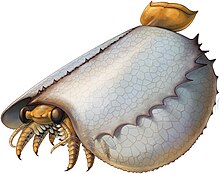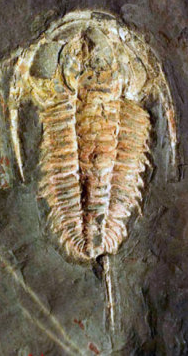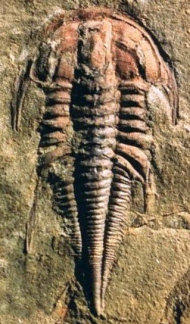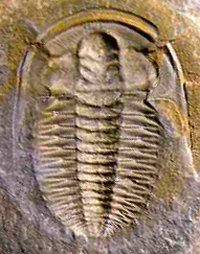Emu Bay Shale
| Emu Bay Shale | |
|---|---|
| Stratigraphic range: | |
Emu Bay |
The Emu Bay Shale is a
Its mode of preservation is
Description
The Emu Bay Shale of
The
The type section of the Emu Bay Shale crops out on the east side of Emu Bay where it conformably overlies the White Point Conglomerate. Here it yields a rich assemblage of Estaingia, Redlichia,
In 2011, seven fossils of large, isolated compound eyes were described from the inland quarry site at Emu Bay, as well as the first well-preserved visual surfaces of the eyes of Anomalocaris. The latter specimens are consistent with anomalocaridids being closely related to arthropods as had been suspected. The find also indicated that advanced arthropod eyes had evolved very early, before the evolution of jointed legs or hardened exoskeletons. The eyes were 30 times more powerful than those of trilobites, long thought to have had the most advanced eyes of any species contemporary with Anomalocaris and which were only able to sense night or day. With more than 16,000 lenses, the resolution of the 3 centimetres (1.2 in) wide eyes would have been rivaled only by that of the modern dragonfly, which has 28,000 lenses in each eye.[6][7][8]
Paleobiota
After Paterson et. al.(2015).[9]
Arthropods
| Arthropods | ||||
|---|---|---|---|---|
| Genus | Species | Notes | Images | |
| Anomalocaris | A. daleyae | An anomalocaridid radiodont closely related to the type species. |  | |
| Echidnacaris | E. briggsi | A tamisiocaridid radiodont. |  | |
| Wisangocaris | W. barbarahardyae | A stem- chelicerate belonging to the Habeliida
|
 | |
| Tuzoia | T. australis, unnamed larger species | A large bivalved arthropod |  | |
| Isoxys | I. communis, I. glaessneri | A bivalved arthropod | ||
| Oestokerkus | O. megacholix | A megacheiran belonging to the family Leanchoiliidae |  | |
| Squamacula | S. buckorum | A basal artiopod
|
 | |
| Australimicola | A. spriggi | A basal artiopod | ||
| Eozetetes | E. gemmelli | A vicissicaudatan artiopod | ||
| Kangacaris | K. zhangi | A nektapsid artiopod belonging to the family Emucarididae |  | |
| Emucaris | Emucaris fava | |||
| Redlichia | R. takooensis, R. rex | A trilobite belonging to the order Redlichiida |  | |
| Holyoakia | H. simpsoni | A trilobite belonging to the order Corynexochida |  | |
| Megapharanaspis | M. nedini | A trilobite belonging to the order Redlichiida | ||
| Balcoracania | B. dailyi | A trilobite belonging to the order Redlichiida |  | |
| Emuella | E. polymera | A trilobite belonging to the order Redlichiida |  | |
| Estaingia | E. bilobata | A trilobite belonging to the order Redlichiida |  | |
Other animals
| Non-arthropod animals | ||||
|---|---|---|---|---|
| Genus | Species | Notes | Images | |
| Nesonektris | N. aldridgei | A member of Vetulicolia |  | |
Vetustovermis
|
A possible member of Nectocarididae | |||
| Myoscolex | M. ateles | An enigmatic animal of unknown affinity. |  | |
| Wronascolex | W. antiquus, W. iacoborum | Palaeoscolecid worm | ||
| Luolishaniidae[9] | Indeterminate | An armoured lobopodian | ||
| Chancelloria | C. australilonga | A member of Chancelloriidae, a group of spiny sponge-like animals. | ||
Demospongiae[9]
|
Spp. | |||
| "Eldonioid"[10] | Indeterminate | Related to Eldonia | ||
Brachiopoda[9]
|
Includes members of the families Botsfordiidae
|
|||
| Hyolitha[9] | ||||
Polychaeta[9]
|
Has possible affinities to Burgessochaeta. | |||
See also
- Lagerstätte—other fossil localities
- List of fossil sites (with link directory)
References
NOTE: Much of the text of this article was used with permission of
- .
- ^ J. B. Jago, Xiaowen Sun and Wen-long Zang (December 2002). "Correlation within early Palaeozoic basins of eastern South Australia" (PDF). pp. 1–22. Archived from the original (PDF) on 2009-10-13. Retrieved 2010-04-04.
- .
- ISSN 1475-4983.
- ^ Pocock, K. J. (1970). "The Emuellidae, a new family of trilobites from the Lower Cambrian of South Australia". Palaeontology. 13: 522–562.
- ^ Brett Williamson (30 June 2011). "Ancient discovery puts world's scientific eyes on Kangaroo Island". ABC News (Australia).
- ^ Salleh, Anna (December 8, 2011). "Cambrian predator had killer eyes". ABC Science. Retrieved 15 February 2012.
- ^ Fossilised eyes of ancient super-predator found Archived 2012-05-12 at the Wayback Machine Australian Geographic December 9, 2011
- ^ S2CID 130614466.
- S2CID 197586878.
Further reading
References about Australian trilobites:
- Hagadorn, J.W. (2002). "Burgess Shale-type Localities: The global picture". In Bottjer, D.J.; W. Etter; J.W. Hagadorn; C.M. Tang (eds.). Exceptional Fossil Preservation -- A Unique View on the Evolution of Marine Life. Columbia University Press. ISBN 978-0231102544.
- Sam Gon III. "A guide to the Orders of Trilobites". Retrieved August 23, 2005.
- Nedin, C. (1995). "The Emu Bay Shale, a Lower Cambrian fossil Lagerstätte, Kangaroo Island, South Australia". Memoirs of the Association of Australasian Palaeontologists. 18: 31–40.
- Simpson, Dave. "Trilobites of South Australia". Archived from the original on February 19, 2006. Retrieved August 23, 2005.
